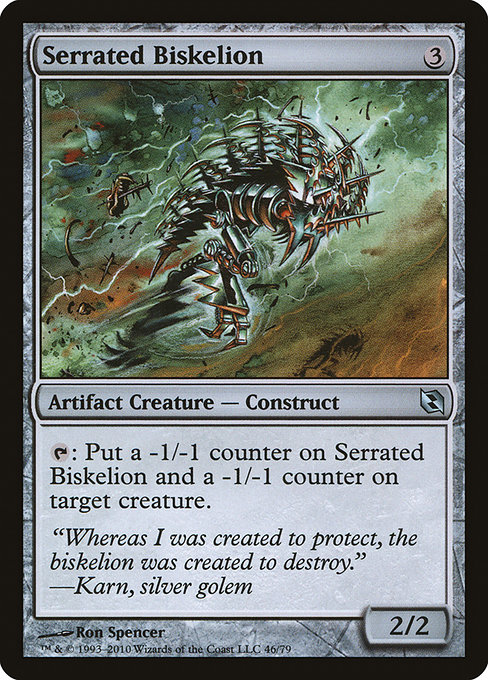
Image courtesy of Scryfall.com
Advanced stack timing with Serrated Biskelion
In the land of colorless artifacts, Serrated Biskelion stands out not for flashy mana costs or flashy damage, but for the delicate timing of its -1/-1 counter economy. With a humble {3} mana and a 2/2 body, this construct invites you to think in terms of the stack and triumph through precise sequencing. Its activated ability—{T}: Put a -1/-1 counter on this creature and a -1/-1 counter on target creature.—is a compact engine for controlled board interaction. In formats where it’s legal, including Commander, Legacy, and of course standard-leaning duel decks like Duel Decks: Elspeth vs. Tezzeret, Serrated Biskelion rewards patient, cunning play 🧙♂️🔥.
What makes this card sing on the stack is that you decide both the timing and the target when you activate. The ability goes onto the stack with a specific target chosen at activation, and the effect will resolve later—perfect for weaving in responses from your opponents. The creature itself bears the cost of activation in the most articulate way: every activation lends the source itself a -1/-1 counter, nudging it toward a natural, self-sacrificial arc if you push too far. The flavor text—“Whereas I was created to protect, the biskelion was created to destroy.”—feels like a wink to the underlying arithmetic of the card: the tool meant to deter a threat might eventually be the one that tips the scales when you time it just right 🔥.
Let’s anchor this discussion in a concrete timing example. Suppose you have Serrated Biskelion on the battlefield and two opposing creatures threaten to overwhelm you: X is a 3/3 and Y is a 2/2. On your turn, you activate Biskelion’s ability (A1) targeting X. The spell pings the stack, opening a window for your opponent to respond with removal or a counterspell. If they wait, you can let A1 resolve and place a -1/-1 counter on Biskelion and on X. But here’s the trick: you can stack a second activation (A2) targeting Y before A1 resolves, placing another -1/-1 on Biskelion and on Y. When A2 resolves first, Biskelion drops to 1/1 and Y becomes a 1/1. Then A1 resolves, placing another -1/-1 on Biskelion (dropping it to 0/0) and on X. The end result is a board with X and Y both bearing -1/-1 counters and Serrated Biskelion having sacrificed itself to the fate it helped create. If you’ve got a follow-up plan—like reusing a mana or untap effect to recast Biskelion on the next turn—you’ve engineered a controlled board wipe with minimal mana investment. It’s a micro-lesson in how to leverage the stack to force trades you wouldn’t get through raw stats alone ⚔️.
For the truly theory-obsessed, there’s a layered tempo you can chase: use a second activation to push extra counters onto your own blocker while thinning the opponent’s board at the same time. If you pair Serrated Biskelion with a card that untaps artifacts (think classic untap shenanigans in the broader MTG space) or with a copy effect, you can push multiple activations in a single turn. The legendary trick with Rings of Brighthearth—an artifact that can copy activated abilities you control—is a perfect example of design that invites exponential timing complexity. Copying Biskelion’s ability not only shoves -1/-1 counters onto a second target but can also apply a second counter to the original Biskelion on the copy, accelerating the life-and-death dance of the board. If the original Biskelion is still present, you can weave a cascade of counters across multiple targets; if not, you still end up with a powerful board-preservation line where your targets pay the cost while Biskelion’s own life ends in a dramatic flourish 🌪️🎨.
In practical terms, think about building around the timing window: what can you achieve by choosing your target with care and sequencing activations to fit into or disrupt your opponent’s turn? If your opponent is planning to swing with a large threat, a well-timed activation can blunt that attack by forcing a trade you want or by preparing to threaten a simultaneous removal on multiple creatures. The key is to treat each activation as a move in a chess clock—the stack becomes the board where you calculate outcomes a move or two ahead. And because Serrated Biskelion is colorless, it plays nicely with artifact-centric shells and a toolbox of tutors and payoffs—perfect for those who enjoy the “bang-for-buck” of a well-timed counter-pressure 🧙♂️💎.
Flavor and design interplay here, too. The -1/-1 counter mechanic is a classic representative of decline and eroding strength, which mirrors Karn’s quiet recognition of the artifact’s dual nature: protect and destroy. Serrated Biskelion doesn’t win the game by raw aggression; it wins by manipulating the flow of the stack and turning tempo into inevitability. That elegance is what makes ancient artifacts feel timeless, even as new cards arrive to tempt us with flashier effects 🎨.
As you calibrate your deck around Serrated Biskelion, remember that this artifact construct is also a reminder of how MTG rewards careful timing and structural thinking. The card’s 3-mana investment buys a steady trickster that can transform a single activation into a multi-creature exchange, especially when you have a plan for extra activations, copies, or untap effects. It’s a perfect case study in how “small” cards can become the backbone of complex stack gamesmanship, where every decision matters and every counter counts 🧙♂️🔥.
Clear Silicone Phone Case Slim Flexible with Open PortsMore from our network
- https://crypto-acolytes.xyz/blog/post/inflammation-tops-cholesterol-in-predicting-heart-disease-risk/
- https://blog.digital-vault.xyz/blog/post/red-green-gruul-strategies-for-jwari-shapeshifter/
- https://blog.digital-vault.xyz/blog/post/calculating-trigger-probabilities-for-rakeclaw-gargantuan/
- https://crypto-acolytes.xyz/blog/post/high-proper-motion-reveals-distant-hot-blue-star-neighborhood/
- https://crypto-acolytes.xyz/blog/post/how-fomc-meetings-trigger-day-trading-opportunities/